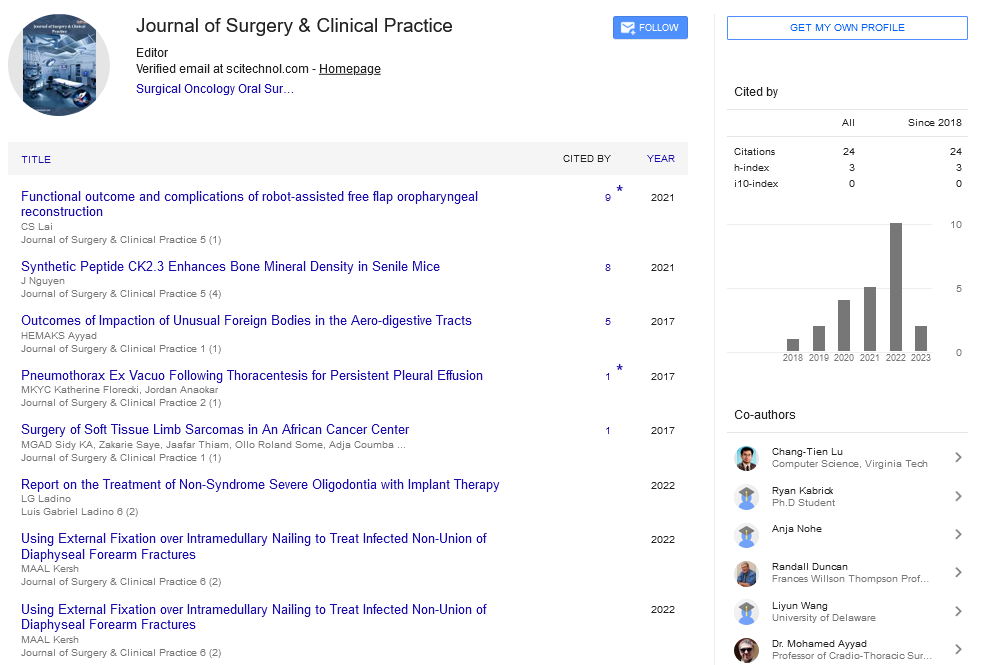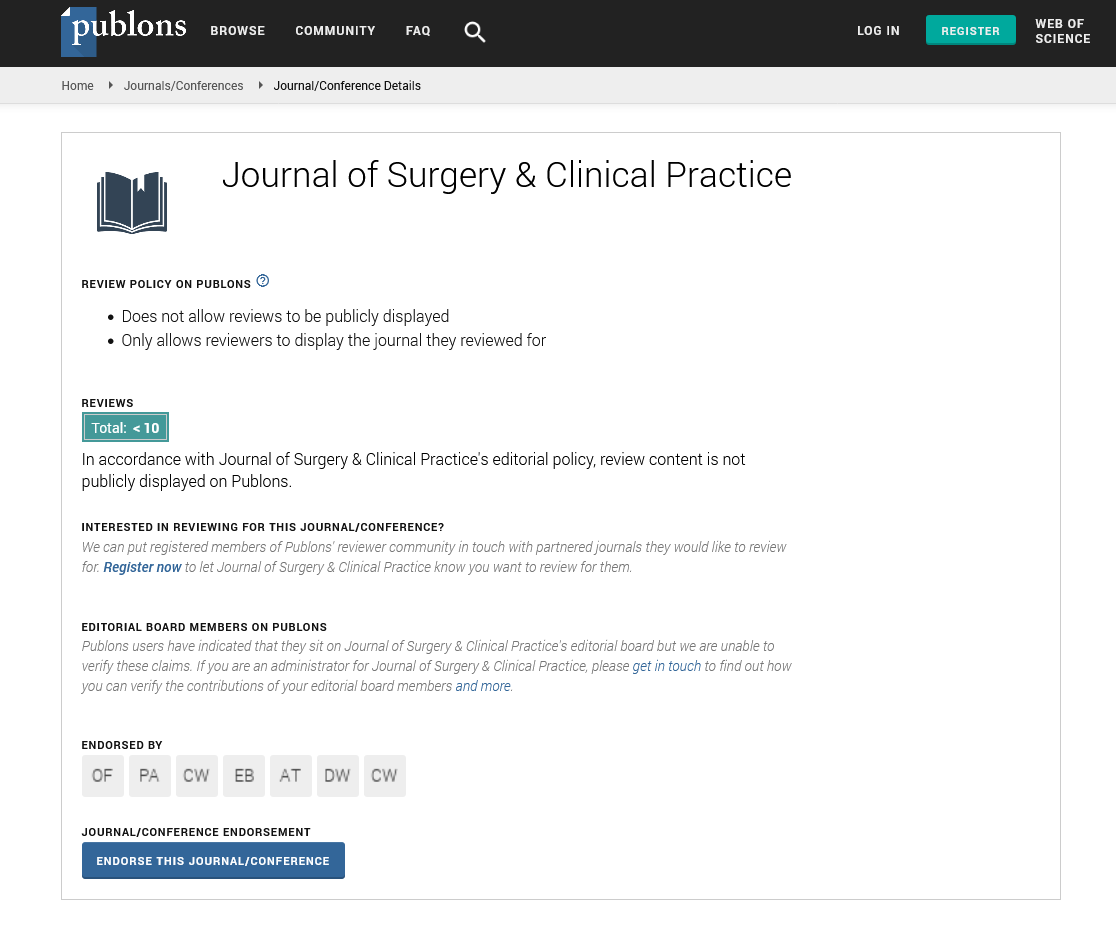Opinion Article, J Surgclinprac Vol: 6 Issue: 2
Using External Fixation over Intramedullary Nailing to Treat Infected Non-Union of Diaphyseal Forearm Fractures
Mohamed Ahmed AL Kersh*
Department of Orthopedic Surgery, Ain Shams University, Cairo, Egypt
*Corresponding Author: Mohamed Ahmed AL Kersh
Department of Orthopedic Surgery, Ain Shams University, Cairo, Egypt
Email: ahmed.mohammedkersh@yahoo.com
Received date: 04 March, 2022, Manuscript No. JSCP-22-56428;
Editor assigned date: 07 March, 2022, PreQC No. JSCP-22-56428(PQ);
Reviewed date: 18 March, 2022, QC No JSCP-22-56428;
Revised date: 28 March, 2022, Manuscript No. JSCP-22-56428(R);
Published date: 04 April, 2022, DOI: 10.4172/jscp.1000360.
Citation: Kersh MAL (2022) Using External Fixation over Intramedullary Nailing to Treat Infected Non-Union of Diaphyseal Forearm Fractures. J Surg.Clin.Prac 6:2.
Keywords: Diaphyseal Forearm Fractures
Introduction
There are no published series on the treatment of infected nonunion of the diaphysis of the forearm bones. From 2014 to 2018, we wanted to see if a systematic treatment approach we used for 21 patients resulted in a high union rate, infection clearance, and a good functional outcome. The study included fourteen male and seven female patients who had an infected nonunion of the diaphysis of the radius or ulna when they came to our hospital. Every patient was followed for at least two years. The average age of the patients was 35.3 years (range 21-45). Thirteen patients had both the radius and ulna shattered at the outset. Six individuals had isolated radius fractures, while two others had ulna-only fractures. All patients were treated with a procedure that included rigorous surgical debridement, intramedullary flexible nail fixation, and external fixation in the same session, followed by tricortical iliac crest bone grafting for segmental abnormalities after 6 weeks. We wanted to share our nonunion repair success rate, number of re-interventions, complication rate, final ROM, and capacity to eliminate infection with this treatment regimen. With at least 50 of supination/pronation and 30 days-130 days of flexion/extension arc at follow-up, all patients had totally united and the infection had been cured. The average time it took to get married was 131 days (range 100 days-183 days). Our conventional strategy for treating infected nonunion of the shafts of the radius and ulna is reliable at achieving fracture union with a satisfactory functional result while also resolving the infection, according to the findings of this study.
Union Rate of Forearm Fractures
The predicted union rate of forearm fractures has been greater than 95% when using AO fracture fixing techniques and compression plates in the treatment of forearm fractures. Infection rates after ORIF of diaphysis forearm fractures have been reported to range from 2% to 6% in the literature, however infection rates are typically greater in developing countries with less economic resources. Because of the existence of bone necrosis, segmental bone defect, sinus tract formation, fracture instability, and scar adhesion of the soft tissues, infected non unions in the forearm are regarded a difficult problem. Only a few studies particularly dealing with infected diaphyseal nonunion of the radius and ulna exist. The majority of forearm literatures either focus only on aseptic nonunion or include various etiologies of forearm nonunion together. Several more studies look at diseased nonunion of long bones as a whole. The main goals of our treatment protocol for infected diaphyseal forearm fractures are to adequately eradicate all infections of bone and soft tissue by removing all sequestrate and implants and reaming the medulla, to achieve bone union with combined internal and external fixation, and to achieve an optimal functional outcome. The goal of the study was to look at the outcomes of this procedure for 21 patients who were treated at our facility between 2014 and 2018. Infected Nonunion of Forearm Bone Fractures A retrospective case series investigation was undertaken after receiving consent from our institutional analyze board to review all patients treated in our institute for infected nonunion of forearm bone fractures, either radius alone, ulna alone, or both bone forearm, between 2014 and 2018. Patients had to be skeletally developed (at least 18 years old) and have non-united, infected diaphysis forearm fractures with at least a 2-year follow-up. The first author treated all of the cases using the same treatment strategy as described subsequently. Nonunion was described as an unstable fracture with no progressive healing after three radiographs, or the persistence of an evident nonunited fracture for at least four months after injury. Clinical, laboratory, and radiographic criteria were used to assess if the patients had an infected nonunion. Erythema or warmth around incision sites, purulent discharge or palpable abscess, a draining sinus tract, localized discomfort, gross mobility at the fracture site, and systemic symptoms of infection were among the clinical markers. White Blood Cell (WBC) count and Erythrocyte Sedimentation Rate (ESR) were examined as part of routine laboratory tests. All of our patients experienced similar infection-related symptoms, as well as an elevated white blood cell count and ESR. Persistent radiolucent lines or an evident gap at the fracture site were looked for on radiographs, as well as osteolysis, implant loosening or failure, and periosteal response. In this study, a single surgeon treated a total of 21 consecutive patients. There are fourteen males and seven females in the study, with an average patient age of 5 years (range 21 years-45 years). In 11 of the 21 individuals, the dominant arm was affected (52%). Six falls, nine Motor Vehicle Collisions (MVCs), and six crush injuries were among the injury mechanisms. The open fractures accounted for 12 of the injuries. They'd all had open reduction and internal fixation before. Thirteen patients (62%) had both the radius and ulna fractured, six patients (29%) had an isolated radius fracture, and two patients had only the ulna fractured (8%). All of the patients had infections at the nonunion location. Eight of the patients were regular smokers. Two of the patients had insulin-dependent diabetes mellitus, so they had several comorbidities. Psychiatric issues had been treated in two of the patients. Fourteen individuals were first treated at a different facility.
Adjunctive External Fixation in Long Bones
The majority of papers deal with the treatment of infected nonunion in the lower extremities, particularly tibia nonunion. Few manuscripts deal with infected non-union of forearm fractures the majority of studies were either single case report, in conjunction with non-infected forearm nonunion or in conjunction with infected non-union of other long bones. Only one study has looked specifically at infected forearm nonunion. The authors discuss their results with the transfer of a vascularized fibular graft to generate a one-bone forearm in this case series of four patients. Internal fixation was used to secure the graft to the ulna proximally and the radius distally. Adjunctive external fixation was required in three of the cases, and one patient required extra supplemental bone grafting. Previously, the open technique of bone grafting for patients with extensive segmental bone defects caused by persistent osteomyelitis was described. The authors of these investigations stressed the importance of delayed secondary skin closure. They also mentioned that solid skeletal fixation was an important part of the procedure. These researchers simply employed autologous bone grafts to avoid the substantial morbidity associated with vascularized bone transfer. In our study, we depend on good debridement and optimal skeletal fixation for treatment of infected nonunion of forearm fractures, no manuscript discussed before the use of combined fixation method for the treatment of infected nonunion of forearm fractures, With the use of this protocol for treatment of infected nonunion of forearm fractures, we obtained infection free union for all patients with functional range of motion. In this study, we rely on good debridement and optimal skeletal fixation for the treatment of infected nonunion of forearm fractures. No manuscript had before discussed the use of a combined fixation method for the treatment of infected nonunion of forearm fractures. Full union of all patients was obtained based on our findings, as well as functional range of motion of the elbow and forearm. With some forearm pronation constraint, good elbow flexion, extension, and supination were achieved. Only two patients showed delayed union based on our findings, and both had a history of heavy smoking. Infected nonunion of the forearm fracture can be effectively treated with a combination of intramedullary and external fixation following thorough debridement.
 Spanish
Spanish  Chinese
Chinese  Russian
Russian  German
German  French
French  Japanese
Japanese  Portuguese
Portuguese  Hindi
Hindi 
